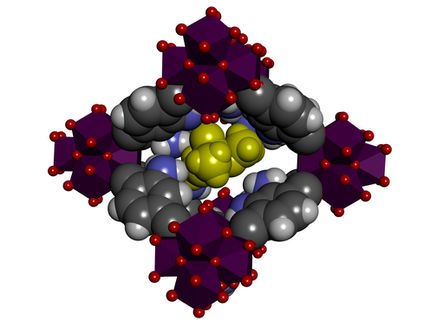New fabric coating could thwart chemical weapons, save lives
chemical weapons are nightmarish. In a millisecond, they can kill hundreds, if not thousands. But, in a study, scientists report that they have developed a way to adhere a lightweight coating onto fabrics that is capable of neutralizing a subclass of these toxins -- those that are delivered through the skin. The life-saving technique could eventually be used to protect soldiers and emergency responders.

A new fabric coating could neutralize chemical weapons and help save countless lives.
American Chemical Society
Since their first use in World War I, dozens of chemical weapons with devastating potential have been developed. For example, just a pinprick-sized droplet of the nerve gas sarin on the skin is lethal. Recently, scientists have begun exploring the use of zirconium-based metal-organic framework (MOF) powders to degrade and destroy these harmful compounds. MOFs are miniscule, porous structures that have large surface areas that allow them to absorb vast amounts of gases and other substances. The zirconium within them helps neutralize toxic materials. But making MOFs can be tedious, requiring high temperatures and long reaction times. Plus, most MOF powders are unstable and incorporating them onto clothing has proven challenging. Dennis Lee, Gregory N. Parsons and colleagues wanted to see if they could "grow" MOFs onto fabric at room temperature, potentially creating a lightweight shield that could be used on uniforms and protective clothing.
Building on previous work, the researchers exposed polypropylene, a nonwoven fabric commonly used in reusable shopping bags and some clothing, to a mixture consisting of a zirconium-based MOF, a solvent and two binding agents. To ensure that the coating spread evenly across the cloth, they treated the fabrics with thin layers of aluminum, titanium or zinc oxide. They tested this combination with dimethyl 4-nitrophenyl phosphate (DMNP), a relatively harmless molecule that has similar reactivity as sarin, soman and other nerve agents. They found that the MOF-treated cloths deactivated the DMNP in less than 5 minutes, suggesting this process is a viable means to create improved protective clothing.
Original publication
Most read news
Original publication
Dennis T. Lee, Junjie Zhao, Gregory W. Peterson, and Gregory N. Parsons; "Catalytic “MOF-Cloth” Formed via Directed Supramolecular Assembly of UiO-66-NH2 Crystals on Atomic Layer Deposition-Coated Textiles for Rapid Degradation of Chemical Warfare Agent Simulants"; Chemistry of Materials; 2017
Topics
Organizations
Other news from the department science

Get the chemical industry in your inbox
By submitting this form you agree that LUMITOS AG will send you the newsletter(s) selected above by email. Your data will not be passed on to third parties. Your data will be stored and processed in accordance with our data protection regulations. LUMITOS may contact you by email for the purpose of advertising or market and opinion surveys. You can revoke your consent at any time without giving reasons to LUMITOS AG, Ernst-Augustin-Str. 2, 12489 Berlin, Germany or by e-mail at revoke@lumitos.com with effect for the future. In addition, each email contains a link to unsubscribe from the corresponding newsletter.


























































